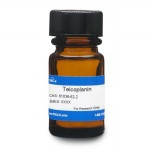TOKU-E
Research Antibiotics, Teicoplanin, 100mg
- Part Number:
- TOK-T002-100mg
- Lead Time:
- 2-3 days
- Shipping:
- FREE SHIPPING on most orders over $50*
- Quantity:
- each
- Size:
- 100 mg
- Style:
- chemical
Description
Teicoplanin, 100 mg. Teicoplanin (also called Targocid or Teichomycin) is a lipoglycopeptide complex first reported from Actinoplanes teichomyceticus in 1978. Teicoplanin is a mixture of several compounds; 5 major compounds, Teicoplanin A2-1 thru A2-5, and 4 minor compounds, referred to as related substances 1 to 4 or teicoplanin RS1-4. All teicoplanin compounds share the same glycopeptide core, termed teicoplanin A3-1, a fused ring structure to which two carbohydrates (mannose and N-acetylglucosamine) are attached.
Teicoplanin has a similar spectrum of activity as vancomycin and is effective against gram-positive bacteria, including methicillin-resistant Staphylococcus aureus (MRSA) and Enterococcus faecalis.
Teicoplanin is a cell wall synthesis inhibitor that works by inhibiting peptidoglycan synthesis and polymerization in two ways. One mechanism inhibits N-acetylmuramic acid (NAM) and N-acetylglucosamine (NAG) from coming together to form the peptidoglycan backbone. Another mechanism prevents cross-linking between amino acid residues in the peptidoglycan chain.
Teicoplanin is sparingly soluble in water.
- Category: Microbiology
- CAS Number: 61036-62-2
- Molecular Formula:
- A2-1 (CAS 91032-34-7) C88H95Cl2N9O33|1877.64|
- A2-2 (CAS 91032-26-7) C88H97Cl2N9O33|1879.65|
- A2-3 (CAS 91032-36-9) C88H97Cl2N9O33|1879.65|
- A2-4 (CAS 91032-37-0) C89H99Cl2N9O33|1893.68|
- A2-5 (CAS 91032-38-1) C89H99Cl2N9O33|1893.68|
- A3-1 (CAS 93616-27-4) C72H68Cl2N8O28|1564.25|
- A3-2 (CAS 91032-39-2) C66H58Cl2N8O23|1402.11|
- Molecular Weight: Varies
- Mechanism of Action: Teicoplanin prevents peptidoglycan synthesis and polymerization by two separate mechanisms. One mechanism prevents N-acetylmuramic acid (NAM) and N-acetylglucosamine (NAG) from linking together forming the peptidoglycan backbone. The second mechanism prevents cross-linking between amino acid residues in the peptidoglycan chain. This mechanism is nearly identical to vancomycin; however, teicoplanin is considered a safer drug due to its lower nephrotoxicity and ototoxicity.
- Storage Conditions: 2-8°C
- Tariff Code: 2941.90.3000
- Spectrum: Teicoplanin targets primarily gram-positive bacteria especially those resistant to methicillin. These include the drug resistant superbug, MRSA (Methicillin resistant Staphylococcus aureus) and Enterococcus faecalis. Teicoplanin is effective for treating MRSA infections because it inhibits cell wall synthesis through a different mechanism than β-lactam antibiotics.
Teicoplanin is similar but not identical to vancomycin in its spectrum of activity. The MICs for most gram-positive bacteria and anaerobes are comparable, but teicoplanin is less active against some strains of Staph. haemolyticus (MIC 16–64 mg/Compared to ≤4 mg/L for vancomycin). Both VanA-type VRE and VISA isolates are also resistant to teicoplanin.
Microbiology Applications
Antimicrobial Susceptibility Testing (AST & MIC) teicoplanin is commonly used in clinical in vitro microbiological antimicrobial susceptibility tests (panels, discs, and MIC strips) against Gram positive microbial isolates. Medical microbiologists use AST results to recommend antibiotic treatment options for infected patients. Representative MIC values include:
- Enterococcus faecalis 0.06 μg/mL - 0.25 μg/mL
- Methicillin-resistant Staphylococcus aureus 0.125 μg/mL - >64 μg/mL
Specifications
- Form: powder
- Appearance: white to light yellowish powder
- Elemental Analysis: Composition:
- Teicoplanins A2: ≥80.0%
- Teicoplanins A3: ≤15.0%
- Other Impurities: ≤5.0%
- Impurity Profile: Impurity A| 4-methylpent-3-en-2-one(mesityl oxide)|141-79-7|C6H10O|98.14|
- pH: 6.3 - 7.7
- Assay (on a dried basis): Not less than 900 µg/mg
- Heavy Metals: Not more than 20 ppm
- Residual Solvents: Complies
References
Murphy, S., and R. J. Pinney. "Teicoplanin or Vancomycin in the Treatment of Gram–positive Infections?" Journal of Clinical Pharmacy and Therapeutics 20.1 (2008): 5-11. Web. 15 Nov. 2012.
Joshi, S., Ray, P., Manchanda, V., Bajaj, J., Chitnis, D. S., Gautam, V., &...Balaji, V. (2013). Methicillin resistant Staphylococcus aureus (MRSA) in India: Prevalence & susceptibility pattern. Indian Journal Of Medical Research, 137(2), 363-369
Available Documents
Made by an ISO 9001:2015 certified antibiotic manufacturer focused on creating antibiotics through fermentation.
By removing contamination and streamlining gene selection, these research antibiotics help scientists make discoveries in cell/plant biology, microbiology, virology, stem cell therapy, and cancer research. Specializing in the pharmaceutical and biotech research sectors.
These products are specifically designed for research use and are not approved for human or animal consumption. Not FDA approved.
Note: These chemicals are for research & laboratory use only. Your order will not be processed if you do not ship to a registered laboratory or research facility.
Please note: This product is not returnable.

